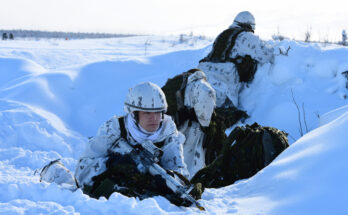
Saudi King Salman bin Abdulaziz al-Saud (L), seen with Russian President Vladimir Putin in 2017. – Kremlin
Emergence of the novel coronavirus COVID-19 has upended the global economic outlook for the upcoming year. Governments around the world have been forced to reassess their budgets and enact new fiscal policies to counteract falling economic activity. The virus has dominated global headlines since it spread beyond China to become a pandemic afflicting over 180 countries and territories at the time of writing, with tens of thousands of deaths.
In this sort of environment, the subject of military conflict seems like an afterthought. This is in stark contrast to the prevailing mood at the start of the year, when fear of “World War III”– or, less dramatically, fear of a direct war between the U.S. and Iran – drove the news. The changing circumstances have driven the price of oil downwards, putting pressure on the spending power of countries reliant on the sale of the commodity to finance their fiscal agenda, such as Saudi Arabia, which is one of the world’s largest producers. Saudi defense spending is likely to take a hit from the developments.
The U.S. carried out a strike on January 3 that killed top Iranian commander Qassem Soleimani, prompting fear of a direct conflict between the U.S. and Iran that could conceivably cut into energy supplies from one of the world’s most important regions. Only a few months later, the world is awash in oil no one wants. On the first day of April, Brent Crude, a benchmark oil price, is trading around $25 per barrel, having fallen from around $66 per barrel at the start of the year.
Disagreement between Moscow and Riyadh how to respond to the drop in demand for oil ruptured their temporary energy alliance, which had been forged in the wake of the last collapse of energy prices, in the mid-2010s. Whereas Saudi Arabia sought further energy production cuts that might shore up the price of oil, Russia took the opposite viewpoint. In early March, the differences prompted a breakdown, and both Russia and Saudi Arabia threatened to introduce new supply into the global market. There is no longer any concern about a shooting war driving the cost of oil up, but rather a pricing war driving it down, as energy producers jockey for market share.
In response, Saudi Arabia announced in mid-March that it was amending its 2020 budget. The budget had been formulated last year, when oil prices appeared set to average $50-$60 per barrel for the upcoming year. But those expectations have become unrealistic, prompting a cut of about SAR50 billion ($13.3 billion) to the overall Saudi budget to account for the reduced income. One casualty of the spending cuts could prove to be the defense budget, which, as officially reported, has already been on the decline for years.
Saudi defense spending peaked at over SAR300 billion annually in the period 2014-2015. Buoyant energy prices – at well over $100 per barrel – had been driving the spending upward under the late King Abdullah bin Abdulaziz al-Saud. Oil started crashing in late 2014. However, in March 2015, two months after King Abdullah’s passing and the start of his brother King Salman’s rule, Saudi Arabia launched a military campaign in Yemen. This campaign aimed to restore control of the capital, Sana’a, to the U.N.-recognized government, which had been ousted by the rebel group Ansar Allah (more commonly referred to as the Houthis). The Kingdom’s offensive operation in Yemen marked a dramatic step in its approach not only to Yemen but also to military defense generally, as the Saudi military had usually taken a more defensive posture.
Whether by personal inclination or purely driven by the energy markets, and despite the military campaign in Yemen (which remains ongoing), King Salman has mostly cut the defense budget since taking power. The defense budget was cut by a third in 2016, the first full year of King Salman’s rule, as Saudi Arabia began unrolling reform plans to shrink its deficit and diversify its economy. With only one exception – the budget rose about 5 percent in 2017 – King Salman has continued cutting the defense budget ever since. Noticeably, the defense budget has also fallen as a share of the national budget and gross domestic product, reflecting greater prioritization elsewhere.
The pace of the cuts certainly slowed as the price of oil stabilized under OPEC+ arrangements, but the budget did not return to growth. Even before it became apparent that COVID-19 would become a drag on global economic activity, the Saudi government formulated its 2020 budget with a spending cut in mind, aiming for the level of SAR182 billion. This is important to highlight, given that the initial 2020 budget was unveiled only months after apparent Iranian-supported drone and missile attacks struck Saudi oil facilities in Abqaiq and Khurais.
The defense budget may yet fall further, especially if the price of energy remains depressed, as is expected at least for some time, barring an agreement between energy producers to slash supply or miraculous recovery in demand. Of course, Saudi Arabia has some agency in the former, as it could turn off the taps or seek an OPEC+ 2.0 with either Russia or the U.S.
The Saudi defense budget remains the largest in the Middle East and one of the largest globally. At the initially approved level for 2020, Riyadh would still spend around $50 billion on defense. Furthermore, declining annual defense budgets have not exactly led to declining procurement activity in Saudi Arabia. To illustrate the point, take the case of its relationship with its largest supplier, the United States. The Kingdom inked over $100 billion worth of memorandums of understanding for arms with the U.S. in 2017. As of the following year, CNN reported that “only” $14.5 billion – or well over 10 percent – of these memorandums had been converted into firm contracts. This is actually a sizable figure, given that the proposed deals cover a decade’s worth of planned procurement, and some of the more politically controversial weapons sales, such as precision-guided munitions, were held up in the U.S. Congress for some time over their usage in alleged war crimes in Yemen.
From suppliers in the U.S., E.U., and elsewhere, the Kingdom has procured new tanks, air-defense missile launchers, helicopters, corvettes, and artillery batteries. It is said to be in talks for more equipment, such as fighter jets, a pair of Spanish landing platform docks, and hundreds of armored personnel carriers. Politics and diplomacy seem to weigh more heavily on procurement decisions than finances do. It is more likely that the political spat between Canada and Saudi Arabia is the culprit for Riyadh falling as much as C$3.4 billion behind on payments for armored vehicles.
For the short- to medium-term, Saudi Arabia can sustain the purchase of military equipment, even if oil prices remain weak. The Saudi government has hundreds of billions of dollars in reserve assets, and international investors remain eager to extend credit to the Kingdom when it has sought them out. Over the long term, however, the Kingdom recognizes that financing defense procurement may become more challenging as long-term demand for oil recedes in favor of more climate-friendly forms of energy.
The development of a local arms industry, under the Vision 2030 economic reform plan, is in part geared towards reducing import costs. Rather than buy its military needs entirely “off-the-shelf,” Saudi Arabia is looking to have local companies produce components in the supply chain or even finished products. The overall goal, to have 50 percent of the military’s requirements fulfilled domestically, remains aspirational. However, in comparison to past efforts to develop its domestic defense industry, this time around, Saudi Arabia seems to be putting more emphasis on the project.
It is certainly true that the speed at which energy prices collapsed in the last few months stems in part from actions taken by Saudi Arabia itself. But this latest price war demonstrates that while security scares can, and have, provoked temporary spikes in oil prices, the shocks that actually last have been negative for producers. Saudi Arabia hopes “to be the last oilman standing,” as The Economist put it last year, so it may yet play hardball on oil supply. In light of this, the days of Saudi defense budgets over $80 billion, as they were in the mid-2010s, are long gone. In their place is budget consolidation at a level much lower and, by King Salman’s calculations, much more sustainable for the future.
Military markets analyst, covering Eurasia, Middle East, and Africa.




